Related Research Articles

Ferussaciidae is a family of air-breathing land snails, terrestrial pulmonate gastropod mollusks in the superfamily Achatinoidea.

Strophocheilidae is a taxonomic family of air-breathing land snails, terrestrial pulmonate gastropod mollusks in the superfamily Acavoidea.
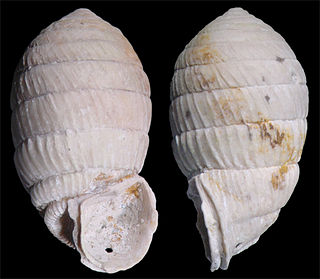
Brasilennea is a fossil genus of small to medium-sized air-breathing land snails, terrestrial pulmonate gastropods in the family Cerionidae. The genus is known only from the Brazilian Paleocene Itaboraí Basin, in Rio de Janeiro. The most characteristic feature of the genus is its two spiral furrows on the body whorl.

Eoborus is a fossil genus of medium-sized air-breathing land snails, terrestrial pulmonate gastropods in the family Strophocheilidae. Eoborus is the oldest fossil record of Strophocheilidae, dating from the Middle Paleocene of Brazil and Uruguay. The Brazilian species, alongside Eoborus charruanus from Uruguay, are the oldest fossil record of the family.

Brasilennea arethusae is a fossil species of air-breathing land snail, a terrestrial pulmonate gastropod mollusk in the family Cerionidae, from the Paleocene Itaboraí Basin, Brazil. Brasilennea arethusae is the largest species in the genus Brasilennea. It was one of the first fossils found in Itaboraí Basin and its name makes reference to the fact that it is a terrestrial species: the name is in honor of Arethusa, a sylvan nymph and one of the Hesperides from Greek mythology.
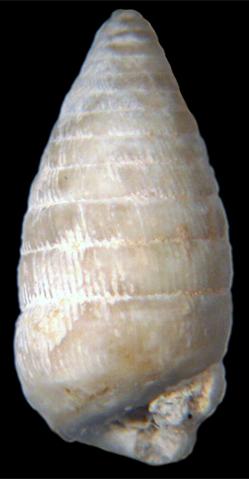
Brasilennea guttula is a fossil species of air-breathing land snail, a terrestrial pulmonate gastropod mollusc in the family Cerionidae, from the Paleocene Itaboraí Basin, Brazil. Brasilennea guttula shows a peculiar shell shape, distinct from the other species in the genus; the shape is reminiscent of a water drop, which led to the specific epithet of Brasilennea guttula.
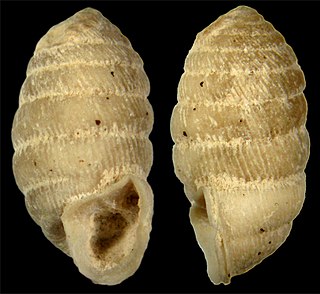
Brasilennea minor is a fossil species of air-breathing land snail, a terrestrial pulmonate gastropod mollusk in the family Cerionidae, from the Paleocene Itaboraí Basin, Brazil. Brasilennea minor is the smallest species in the genus Brasilennea; it was originally described as a smaller variant of Brasilennea arethusae, but was later raised to the rank of species.

Eoborus rotundus is a fossil species of air-breathing land snail, a terrestrial pulmonate gastropod mollusk in the family Strophocheilidae, from the Paleocene Itaboraí Basin, Brazil. Eoborus rotundus is a small species for the genus Eoborus, and the shell has a more rounded shape than average for the genus, a feature reflected in its species name.

Eoborus sanctijosephi is a fossil species of air-breathing land snail, a terrestrial pulmonate gastropod mollusk in the family Strophocheilidae, from the Paleocene Itaboraí Basin, Brazil. Eoborus sanctijosephi is a large species in the genus Eoborus. Its name makes reference to the place of discovery: the São José de Itaboraí municipality, where Itaboraí Basin is located.
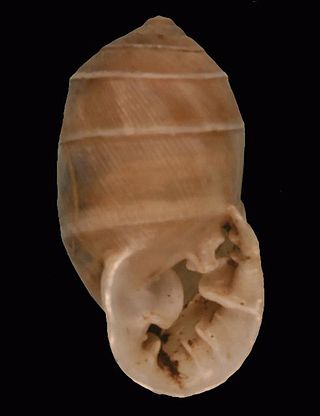
Plagiodontes is a recent genus of small to medium-sized air-breathing land snails, terrestrial pulmonate gastropods in the family Odontostomidae.
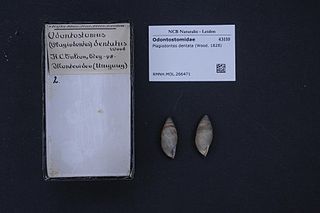
Plagiodontes dentatus is a recent species of small to medium-sized air-breathing land snail, terrestrial pulmonate gastropods in the family Orthalicidae, subfamily Odontostominae. It occurs in Entre Ríos Province, Argentina.

Cortana is a fossil genus of medium-sized air-breathing land snails, terrestrial pulmonate gastropods in the family Bulimulidae. The genus is known only from the Brazilian Paleocene deposits of the Itaboraí Basin, in the state of Rio de Janeiro. The most characteristic feature of the genus is its apertural armature.

Itaborahia is a fossil genus of medium-sized air-breathing land snails, terrestrial pulmonate gastropods in the family Bulimulidae. The genus is known only from the Brazilian Paleocene deposits of the Itaboraí Basin, in the state of Rio de Janeiro.
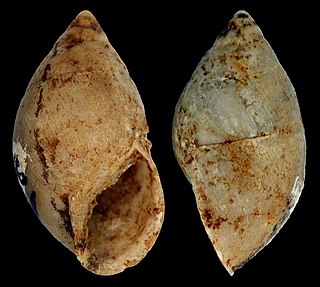
Eoborus fusiforme is a fossil species of air-breathing land snail, a terrestrial pulmonate gastropod mollusk in the family Strophocheilidae, from the Paleocene deposits of the Itaboraí Basin, in the state of Rio de Janeiro, Brazil.
Austrodiscus lopesi is a fossil species of air-breathing land snail, a terrestrial pulmonate gastropod mollusk in the family Charopidae, from the Paleocene deposits of the Itaboraí Basin in Brazil.
Temesa is a genus of medium-sized air-breathing land snails, terrestrial pulmonate gastropods in the family Clausiliidae, the door snails. The fossil record of this genus ranges tentatively from the Brazilian Paleocene of the Itaboraí Basin, in Rio de Janeiro State, where the species T. magalhaesi is found.
Temesa magalhaesi is a fossil species of air-breathing land snail, a terrestrial pulmonate gastropod mollusk in the family Clausiliidae, the door snails. The species is found in the Paleocene deposits of the Itaboraí Basin, in Brazil. This is the oldest{how old?} record of the subfamily, although the species is only tentatively placed in the genus.
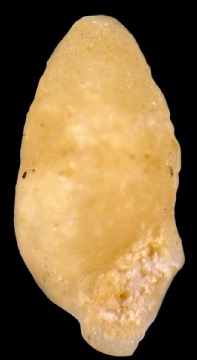
Cecilioides sommeri is a fossil species of minute air-breathing land snail, a terrestrial pulmonate gastropod mollusk in the family Ferussaciidae, from the Paleocene deposits of the Itaboraí Basin, in Brazil. This is the oldest known species in the family.
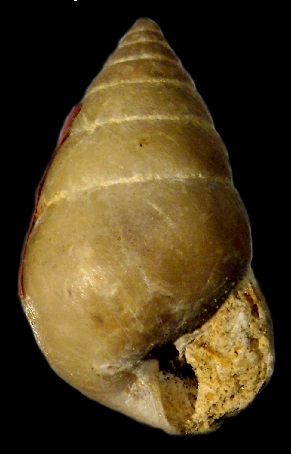
Bulimulus fazendicus is a fossil species of air-breathing land snail, a terrestrial pulmonate gastropod mollusk in the family Bulimulidae, from the Late Paleocene deposits of the Itaboraí Basin in Brazil.
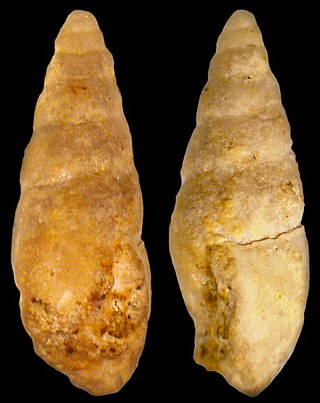
Bulimulus trindadeae is a fossil species of air-breathing land snail, a terrestrial pulmonate gastropod mollusk in the family Bulimulidae, from the Paleocene deposits of the Itaboraí Basin in Brazil.
References
- 1 2 Salvador, Rodrigo Brincalepe; de Simone, Luiz Ricardo Lopes (2013). "Taxonomic revision of the fossil pulmonate mollusks of Itaboraí Basin (Paleocene), Brazil". Papéis Avulsos de Zoologia. doi: 10.1590/S0031-10492013000200001 .